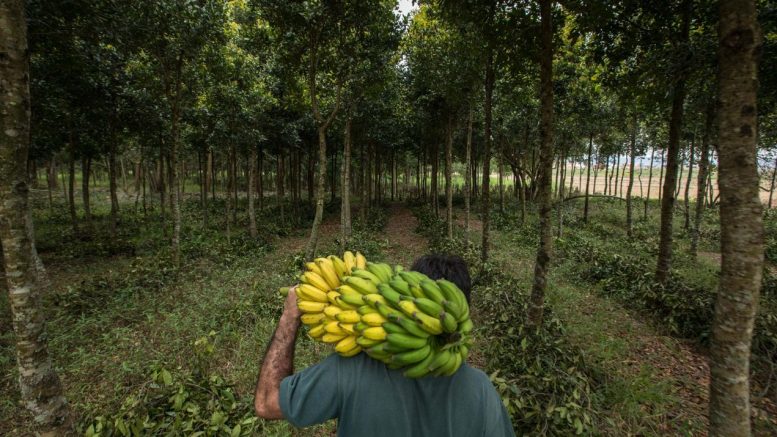“…agroforestry systems can be used to restore environmental liabilities on farms, in compliance with local legislation…”
Natália Leite is a specialist in finance for bioeconomy at The Nature Conservancy – TNC, an environmental engineer from POLI-USP and a master in environmental sciences from PROCAM-USP. She works on the Financial Innovation for the Amazon, Cerrado and Chaco Biomes – IFACC initiative and on other sustainable finance projects at TNC.

Natália Leite, expert at TNC
AgriBrasilis – What are agroforestry systems and what are their benefits?
Natália Leite – IFACC (Financial Innovation for the Amazon, Cerrado and Chaco Biomes) defines agroforestry systems as land use techniques in which perennial species are integrated simultaneously with crops and/or animals. Agroforestries are a solution to reconcile food production with the environmental recovery of already deforested areas, given that they promote the recovery of ecosystem services such as biodiversity, carbon sequestration, soil quality, evapotranspiration, etc. Agroforestry systems are a tool for forest restoration, which is one of the main strategies for mitigating and adapting to climate change.
Furthermore, agroforestry systems can be used to restore environmental liabilities on farms, in compliance with local legislation, accelerating compliance with the Brazilian Forest Code.
Finally, we have the social benefits, since Agroforestry Systems can address the needs of people and communities, paying more per unit of area than annual crops or livestock and promoting food sovereignty.
AgriBrasilis – Where are they located in Brazil?
Natália Leite – According to our analysis of IBGE data, they are present on approximately 490,000 farms in the country. Of these, the Amazon Biome has 46,000, most of which are family farms. In the Cerrado Biome, there are approximately 52,000 farms adopting agroforestry systems, 36,000 in family farming and 16,000 non-family farming, which can be ILPF (integrated crop, livestock and forest) models. The remaining agroforestry systems in Brazil are mainly in the Northeast and South regions.
AgriBrasilis – Financially, is the adoption of agroforestry systems in Brazilian biomes viable?
Natália Leite – Yes, agroforestry systems are viable in all biomes, as long as they are designed specifically for the region where they are located, considering local microclimatic conditions, and topics such as technical assistance, labor, infrastructure and consumer markets.
The study demonstrates the economic viability of three models for the Cerrado Biome, with positive NPV and IRR values ranging from 15% to 79%, with an average of around 30%. They are: a system with native species in partnership with landowners, one hectare dedicated to family farming and finally, a model for a transition zone with the Amazon Biome in areas with irrigation and an integrated system with livestock farming.
AgriBrasilis – What safeguards are necessary for the adoption of agroforestry systems?
Natália Leite – The study provides an in-depth survey of the safeguards that must be observed and respected in the design and implementation of agroforestry systems, to avoid negative socio-environmental impacts. They are divided into social and environmental. The first covers topics such as economic feasibility studies, mapping of suppliers and consumer markets, gender equality, fair working conditions and partnerships with farmers. The second includes a waste management plan, fire-fighting plan, climate adaptation mechanisms, prioritization of native species, among others.
In a comprehensive manner, each and every agroforestry system project must be based on an analysis of risks and unintended negative externalities, which may have consequences for the community, the environment and the results themselves. This analysis will define the risks and respective safeguards relevant to each project.
More important than defining the list of safeguards, actors must create the routines and tools necessary to effectively put them into practice and monitor their compliance.
AgriBrasilis – What is blended finance and why is it important for the expansion of agroforestry systems?
Natália Leite – The combination of resources from different sources in the same financial structure: public, private and philanthropic resources. Although agroforestry systems are considered economically viable, mixed financing provides the necessary conditions to guarantee the desired results and profitability. This can be done in different ways, through the reduction of rates granted to farmers, provision of long-term investment credits, risk mitigation mechanisms to attract greater private capital, or provision of technical assistance and other services to overcome challenges.
AgriBrasilis – What are the government incentives for adopting this production system?
Natália Leite – The success of agroforestry systems will depend on establishing arrangements and partnerships with local, regional and federal entities, including government agents. These can support investments in infrastructure, technical assistance, purchasing programs and other incentives and policies that encourage the expansion of agroforestry systems, aiming to boost the supply of seeds and seedlings, the processing and distribution of products, firefighting, and research and development on the management and application of native species.
READ MORE:

